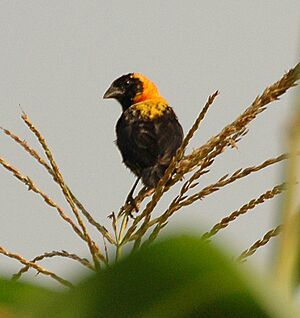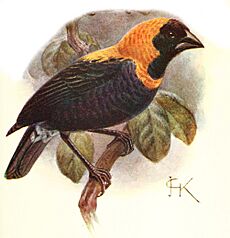Black bishop facts for kids
Quick facts for kids Black bishop |
|
|---|---|
 |
|
| Male in Bigodi Swamp, Uganda | |
| Conservation status | |
| Scientific classification | |
| Genus: |
Euplectes
|
| Species: |
gierowii
|
| Synonyms | |
|
Pyromelana ansorgei |
|
The black bishop (Euplectes gierowii) is a beautiful passerine bird. It lives in Africa, south of the Sahara Desert. This bird belongs to the Ploceidae family. This family includes weavers and other similar birds. There are three different types, or subspecies, of the black bishop.
Contents
Discovering the Black Bishop
The black bishop was first described in 1880. A German bird expert named Jean Cabanis did this. He named the bird after H. Gierow. Gierow was a Swedish explorer. He collected animals in Angola. Sometimes, the black bishop is also called Gierow's bishop.
Types of Black Bishops
There are three main types of black bishops. These are called subspecies. They live in slightly different areas of Africa.
- E. g. ansorgei is also known as the northern black bishop. It lives in places like Cameroon, Ethiopia, Uganda, and Kenya. You can often find it near Lake Victoria. This type is named after Dr. W. J. Ansorge. He was the one who discovered it.
- E. g. gierowii is the original type. It is known as the Angola black bishop. It lives in Angola and the Democratic Republic of the Congo.
- E. g. friederichseni is the southern black bishop. It lives in Kenya and Tanzania. You might see it in places like Serengeti National Park.
What Does the Black Bishop Look Like?
The black bishop is a fairly large bird. It measures about 14 to 16 centimeters (5.5 to 6.3 inches) long.
When the male bird is ready to breed, it looks very striking. Its wings, tail, chest, cheeks, and forehead are black. Its neck and the back of its head are bright orange or orange-red. The feathers under its tail are pale buff with black stripes. The upper part of its back is yellow or orange-yellow. This color changes slightly depending on the subspecies. For example, the ansorgei type has a yellow upper back. The friederichseni type has an orange upper back. The gierowii type has a bright red throat.
Female black bishops look different. They are mostly dark. Their faces have dark sides. They have clear spots on their buff-colored chests. Their wing linings are black.
Young black bishops look a lot like the females. But their chest spots are smaller.
The bird's bill is shaped like a cone. This is typical for birds that eat seeds. Its legs are brown.
Black bishops make various soft, chirping sounds. Some of their calls sound like see-zee see-zee or hishaah, hishaah.
Where Do Black Bishops Live?
The black bishop lives in many countries in Africa. These include Angola, Cameroon, Ethiopia, Kenya, and Tanzania. They like to live in grassy areas. They also enjoy shrublands and wetlands. Wetlands are places like swamps or marshes.
How Do Black Bishops Behave?
Black bishops are not usually found in very large groups. Sometimes, you might see them in small flocks. But they are not very social, especially when they are nesting.
During the breeding season, the male bird protects its own area. This area is called a territory. It makes sure other birds don't come into its space.



